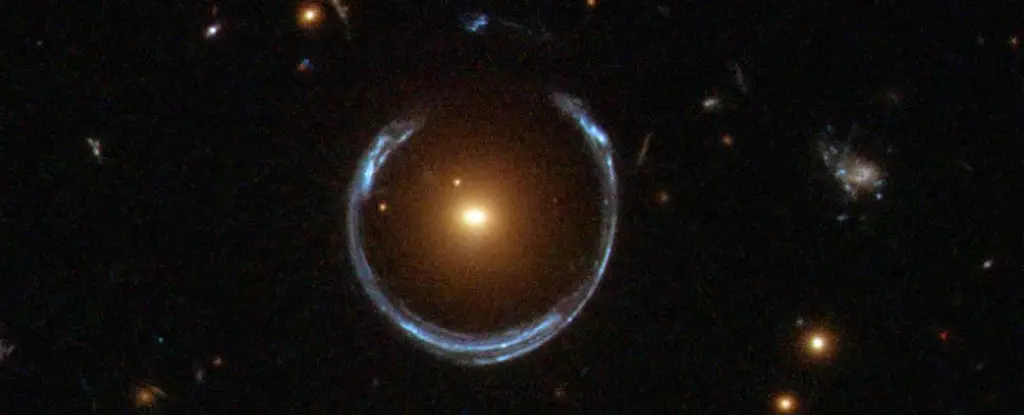In the vastness of the universe, impressive discoveries continue to reshape our understanding of cosmic structures. One such remarkable find is the Cosmic Horseshoe, an astonishing gravitationally lensed system located approximately five and a half billion light-years from Earth. Discovered in 2007, the Cosmic Horseshoe offers astronomers a unique insight into the behavior of light and gravity at astronomical scales. This phenomenon occurs when a massive foreground galaxy distorts and magnifies the light from a distant background galaxy, creating a striking visual known as an Einstein Ring.
Recent research has shed light on the extraordinary attributes of the Cosmic Horseshoe, revealing the existence of an Ultra-Massive Black Hole (UMBH) harboring 36 billion solar masses at its core. While the term UMBH lacks a universally accepted definition, it generally refers to black holes that exceed five billion solar masses, categorizing them amongst the most massive black holes known.
Historically, the identification of supermassive black holes (SMBHs) has evolved considerably. Rather than being “discovered” in the classical sense, their existence has been inferred through continuous observation and measurement over time. The understanding of more massive black holes has led to the nomenclature of UMBHs, which serve to highlight the extremes present within the black hole population.
The newly published research titled “Unveiling a 36 Billion Solar Mass Black Hole at the Center of the Cosmic Horseshoe Gravitational Lens,” spearheaded by Carlos Melo-Carneiro from the Universidade Federal do Rio Grande do Sul in Brazil, marks a significant milestone in our astronomical studies. The findings probe the intricate relationship between the UMBH and the massive galaxy that hosts it, termed LRG 3-757, a Luminous Red Galaxy (LRG) that is extraordinarily massive and bright in infrared light.
A pivotal feature of LRG 3-757 is its mass, which eclipses that of our own Milky Way by about a hundred times, making it one of the heaviest galaxies ever cataloged. The presence of a UMBH in this massive galaxy raises interesting questions about the dynamic interplay between galaxies and their central black holes. Observers note a trend: every massive galaxy seems to house a supermassive black hole, and this interconnectivity plays a vital role in our comprehension of cosmic evolution.
The correlation between black hole mass and the velocity dispersion of stars in the galaxy offers intricate insights into their co-evolution. This MBH-sigmae Relation suggests that as the mass of the galaxy’s black hole increases, so does the random motion of the stars surrounding it. However, LRG 3-757 evidences a significant deviation from this well-established relationship, which promotes further inquiry into the nature of such exceedingly massive black holes.
Research indicates that the Cosmic Horseshoe exists at a distance referred to as z = 0.44 while maintaining an uncommon absence of similarly massive galaxy companions, suggesting that it might belong to a fossil group. Fossil groups, noted for their prominent central galaxies and lack of significant merger activities, might follow a distinct evolutionary path compared to more typical galaxies.
The investigation into LRG 3-757’s UMBH catalyzes queries regarding the apparent segregation from the MBH-sigmae correlation. The researchers raise the possibility that the eccentric motion of stars could stem from earlier galaxy mergers that altered the galaxy’s dynamics. This “scouring” process occurs when massive galaxies combine, potentially expelling stars from the centers of such galaxies, thereby affecting the velocity statistics.
Additionally, the multifaceted influence of Active Galactic Nuclei (AGN) may play a role in altering the structure of host galaxies. The energetic jets from these active black holes can suppress star formation and modify the environment surrounding the black hole. Furthermore, the authors speculate that some UMBHs may represent remnants of intense quasars from an earlier epoch in the universe’s history.
As researchers push for further insights into the intricacies of black hole formation and evolution, observational advancements hold the key. The forthcoming Euclid mission promises to illuminate our understanding by identifying hundreds of thousands of gravitational lenses over the next five years. Furthermore, the Extremely Large Telescope (ELT) is expected to facilitate nuanced examinations of galactic dynamics, propelling studies of black holes into a new era.
The Cosmic Horseshoe underscores the importance of ongoing astronomical research in expanding our grasp of the universe’s complexities. As we seek to unveil the relationship between galaxy growth and black hole development, discoveries of entities like UMBHs will significantly contribute to our collective knowledge of cosmic evolution and the forces that forge the fabric of space-time. Through this journey, we remain on the brink of answering profound questions about our universe, illuminating the intricate dance of galaxies and their extraordinary inhabitants.


Leave a Reply